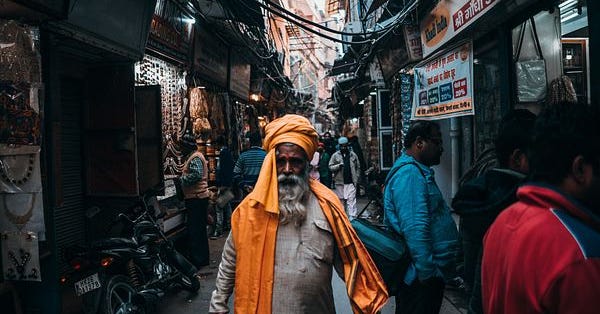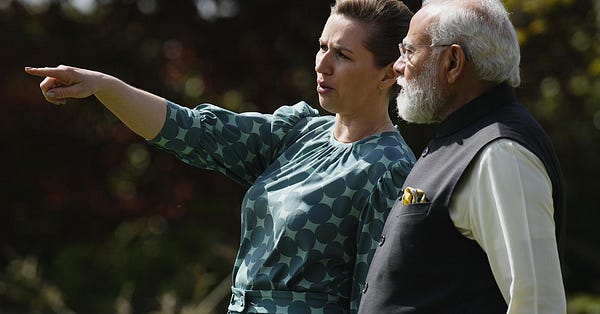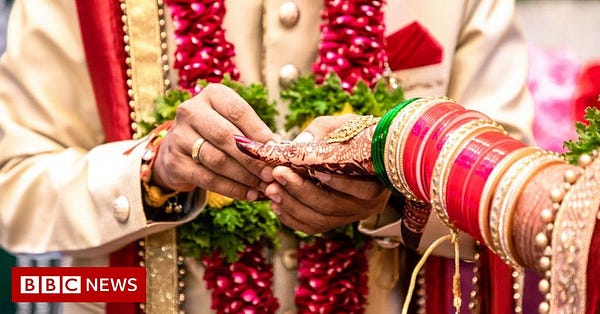How the long-term China challenge has saved India from having to pick between Russia and the West
'Diplomatic sweet spot.'
Thank you for reading India Inside Out. The newsletter hasn’t yet settled into a regular rhythm, but I will continue sending notes by, whenever they are complete, as well as link emails every so often.
If you have suggestions for pieces that ought to be highlighted, send them to rohan.venkat@gmail.com.
And if you missed the last edition, I spoke to historian Priya Satia on how historian-leaders created a framework in which the British Empire believed itself to be progressive even as it brutalised its colonial subjects.
At first, it seemed as if Russia’s invasion of Ukraine might force India to do a tightrope walk to maintain its relations with Moscow – a crucial partner, particularly on the security front – without causing a reversal of its growing ties with Europe and the United States, which had displayed a surprising amount of unity in response to the war. I wrote about this back in March.
Instead of being forced into a corner, however, many observers are now describing India as having found itself in a foreign policy “sweet spot”, as countries around the world seek to draw New Delhi into their camp, or at least convince it to retain the relative neutrality on display so far.
The flurry of diplomatic activity in March continued into April and May, which saw
visits of UK Prime Minister Boris Johnson, Japan Prime Minister Kishida Fumio, European Commission President Ursula Von Der Leyen, Russian Foreign Minister Sergei Lavrov to New Delhi;
virtual meetings between Prime Minister Narendra Modi and Australia Prime Minister Scott Morrison (including the signing of a free trade agreement) as well as US President Joe Biden (in addition to the 2+2 ministerial meetings, of both countries’ defence and external affairs ministers, in Washington DC);
a whole host of senior-level visits coniciding with the Raisina Dialogue, a flagship geopolitical conference co-hosted by the government of India and the Observer Research Foundation;
Modi flying to Europe to meet new German Chancellor Olaf Scholz, re-elected French President Emmanuel Macron and the heads of all of the Nordic countries at a summit in Denmark.
A number of these engagements were planned well before Russia decided to invade Ukraine, yet the fact that they took place regardless – and the tone taken by the leaders of a number of countries following the interactions – suggests that these were more than simply courtesy calls.






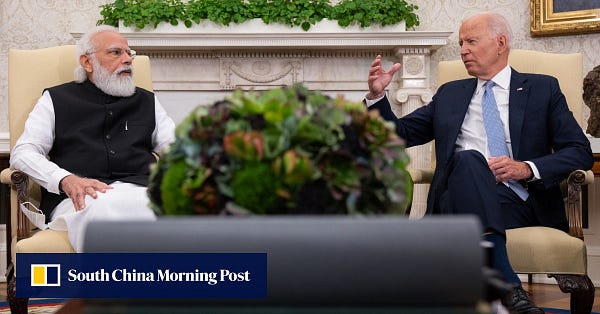
The Financial Times’ Benjamin Parkin summarises the events:
“Emmanuel Macron greeted him with a bear hug in front of the Elysée Palace shortly after he was re-elected French president. In Berlin, German chancellor Olaf Scholz welcomed his “super partner”. UK prime minister Boris Johnson, on a visit to New Delhi, lavished praise on his khaas dost, or special friend.
The bonhomie from European leaders in recent weeks towards Narendra Modi capped a frantic period of international diplomacy for the Indian prime minister, despite his refusal to break ties with Russia over its invasion of Ukraine.
What explains this sweet-spot positioning? Or put differently, despite the American and European desire for a show of unity in the face of Russian aggression, why are Western leaders continuing to court New Delhi, even as it refuses to condemn Moscow?
There are number of potential answers to that question, but broadly speaking you could pick out two principal ones: India’s relative size and relevance coupled with its ‘non-aligned/strategic autonomy' status, and the American (and belated European) recognition that, for all the danger Putin’s Russia represents, the long-term challenge will come from China.
As Hudson Institute Research Fellow Aparna Pande (whom I interviewed in 2020, here), put it to CNBC:
“India is today in an enviable position because of years of careful diplomacy, and fortuitous geo-politics… The US and its partners — in Europe and Asia — need India on their side in the long-term peer competition with China. They are, therefore, more understanding of India’s predicament.”
Indeed, although there have been occasional complaints – see US deputy National Security Advisor Daleep Singh warning of ‘consequences’ for any country that attempts to offer Russia a way around the sanctions – the broad impression appears to be an acceptance of New Delhi’s historical connections with Russia, and an effort to offer India a new way forward on the defence and trade relations front.
This calculation is built on the acceptance of the fact that the real threat in coming years will be from China, not Russia – a point US President Joe Biden has made over and over again. Even as the war in Ukraine dominates headlines, Biden will this month travel to Japan and South Korea to maintain the US’ Indo-Pacific focus.
He will then, on May 24, meet with the other leaders of the Quad, a four-member grouping (India, US, Japan, Australia) that is squarely focused on balancing Beijing’s influence in the Indo-Pacific.
Brookings Institution senior fellow Tanvi Madan has a useful summary of the American calculation regarding India’s ties with Russia:
“[The US] does not like the India-Russia relationship... but for US and other Quad countries the very role they want India to play in the region to balance China... is dependent on [its] capabilities that are of Russian & Soviet origin.”
New Delhi understands this, and has made its diplomatic calculations accordingly. In a piece broadly aimed at explaining New Delhi’s decision-making to an American audience, the Carnegie Endowment for International Peace’s Ashley Tellis explains:
“India behaves—and has always behaved without embarrassment—as political realists imagine states to behave in competitive international politics.
The current Indian strategy of refusing to condemn Russian actions publicly could be undermined by several outcomes: the demise of Russian power or the congealing of a tight Sino-Russian relationship, either of which would deny India the beneficial partnership that it has sought to preserve with Moscow, or highly punitive actions by the United States against India, which would make the immediate costs of New Delhi’s neutrality far more painful than the benefits that India might ultimately derive from its continuing ties with Russia.
At the moment, Indian policymakers are far more concerned about the former problem than the latter. They have judged that, because Washington seeks New Delhi’s cooperation in coping with the threat posed by China in the Indo-Pacific, the United States will be far more forgiving about India’s public neutrality toward Russia even if it happens to occasionally chide New Delhi about the same. Because India matters more to the United States in the Indo-Pacific than it ever could in Europe, Indian leaders have also deduced that Washington will give them a pass as long as India continues to cooperate with the United States in constraining Chinese assertiveness.”
Last month, former Indian Foreign Secretary Shivshankar Menon flipped the framing to contextualise this differently. He argued that, despite the American portrayal of the war in Ukraine as a battle between autocracies and democracies and as an era-defining conflict, the fact that it was taking place at all was actually a reflection of Europe’s fall in significance over the last few decades.
“When Europe was the central fault line in the superpower contest, no wars were fought in the region; borders stayed frozen, lest any change provoke conflict between two nuclear-armed superpowers. But after the Cold War, conflict in Europe—in the former Yugoslavia in the 1990s and today in Ukraine—became neither unthinkable nor fraught with the same risks of annihilation or escalation, despite some alarmist panic about these apocalyptic possibilities today. Europe is a sideshow to the main theater of geopolitical drama: Asia.
Today, the center of gravity of the world economy has moved from the Atlantic to east of the Urals. Geopolitical disputes and security dilemmas that could affect the global order are concentrated in maritime Asia. And the world seeks a new equilibrium to account for China’s rise. The complex political dynamics in Asia don’t lend themselves easily to the kind of stark confrontation underway in Ukraine. Policymakers in Western countries shouldn’t think that their actions on the new frontlines in Europe will shape the contours of a wider struggle to come.”
In other words, it is simply because the principal competition of our age is between the West and China – and not the West and Russia – that the war in Ukraine is being allowed to take place, and carry on for as long as it has.
This puts India on the front-lines of the global faultline and, as a result, gives it more space to maneuver on diplomatic issues that are taking place further afield. But this sweet spot could turn sour easily.
In a piece, Shyam Saran, another former foreign secretary, warned that the courting of India at the moment is based heavily on what the country could come to be over the next few decades, rather than what it is now:
“The attention being paid to India is substantive. This reflects not what India is but rather what India could become as one of the key architects of a new international order. It would be easy to bask in this international prominence and forget that this may soon evaporate if India fails to make the right choices at this time. It is time to think strategically about India’s place in a world which is in the midst of a historic transformation. A rare but perishable opportunity has presented itself to significantly advance India’s long-term prospects. It must be grasped with single-minded tenacity.”
Other pieces to read on the subject:
Where will India buy its weapons, after the Ukraine war, ask Vasabjit Banerjee and Benjamin Tkach.
“Despite this government’s full antipathy for Nehru and only a little less for his daughter, in responding to the current Ukraine situation, it is following the matrix set by them,” writes Vivek Katju.

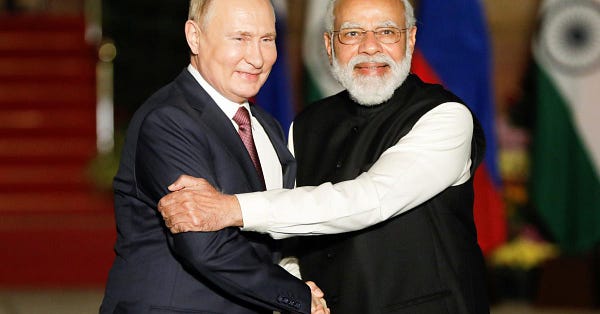
Mihir Sharma argues that Europe’s “deep antipathy to the idea of being caught in a bipolar world defined solely by US-China competition” means it may have more in common with India than is generally appreciated.
Amrita Narlikar and Samir Saran lay out a map to address three key challenges – the green transition, the digital transformation and geopolitics – that would lend themselves to Indo-Europe cooperation.
Linking Out
“Even as India continues to rapidly and visibly regress into a violent majoritarian state, the [foreign policy] community continues to look away,” writes Angshuman Choudhury. “At best, foreign policy voices contend themselves with paying lip service to the values of democracy and pluralism only for geostrategic ends.”

Antara Ghoshal Singh, examining Beijing’s perspectives on India, says “New Delhi should come to terms with the fact that it has leverage with China due to its increasing strategic value to Beijing, whether in the realm of China’s foreign policy or its development strategies, and utilize it to shape Beijing’s behavior and extract benefits from it.”
Darshana Baruah and Caroline Duckworth argue that the Indian Ocean should be seen as one region, instead of the three most countries treat it as right now. The piece comes alongside a new interactive map launched by Carnegie’s Indian Ocean Initiative.
Urmila Chatterjee, Martín Rama and Deepak Varshney take a close look at India’s Covid-19 welfare measures and how they actually played out.
Modi government has been raising misleading objections to stall WHO’s count of Covid-19 deaths, writes Rukmini S.

